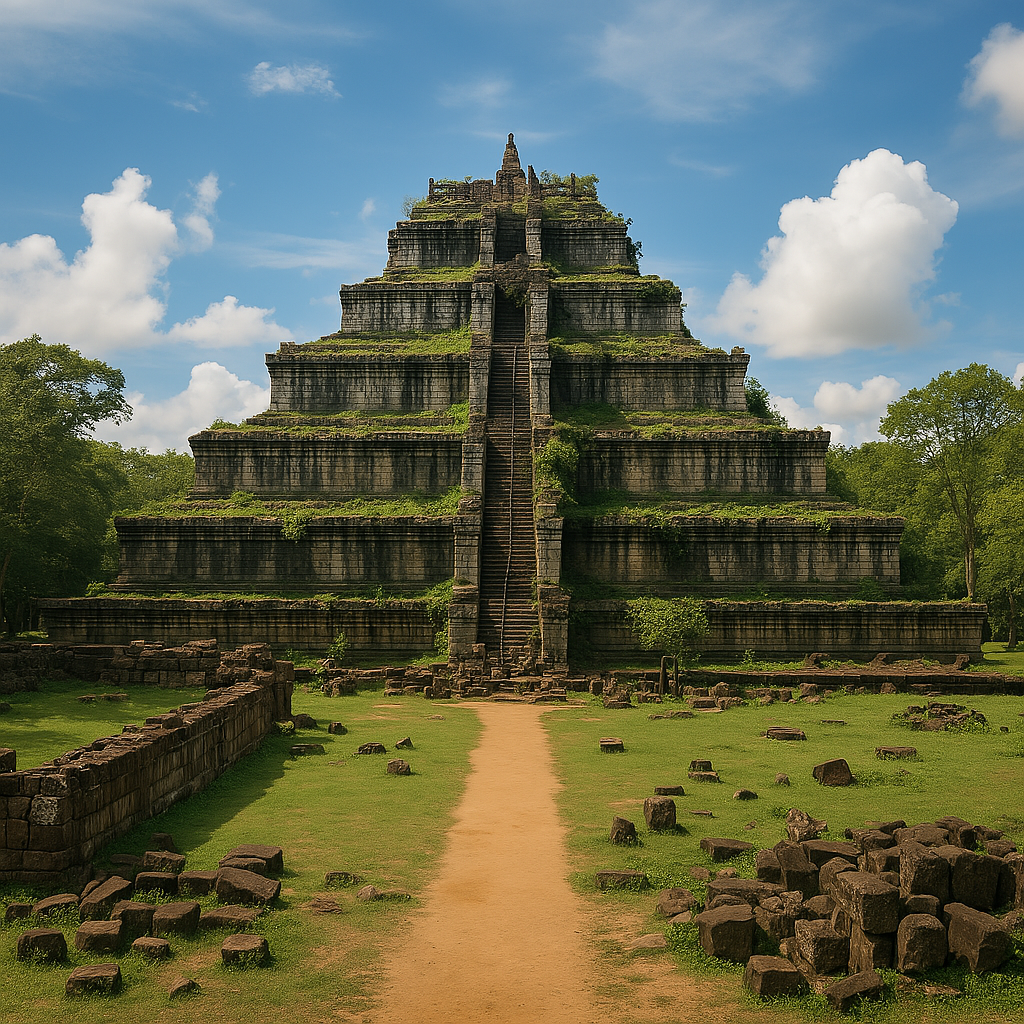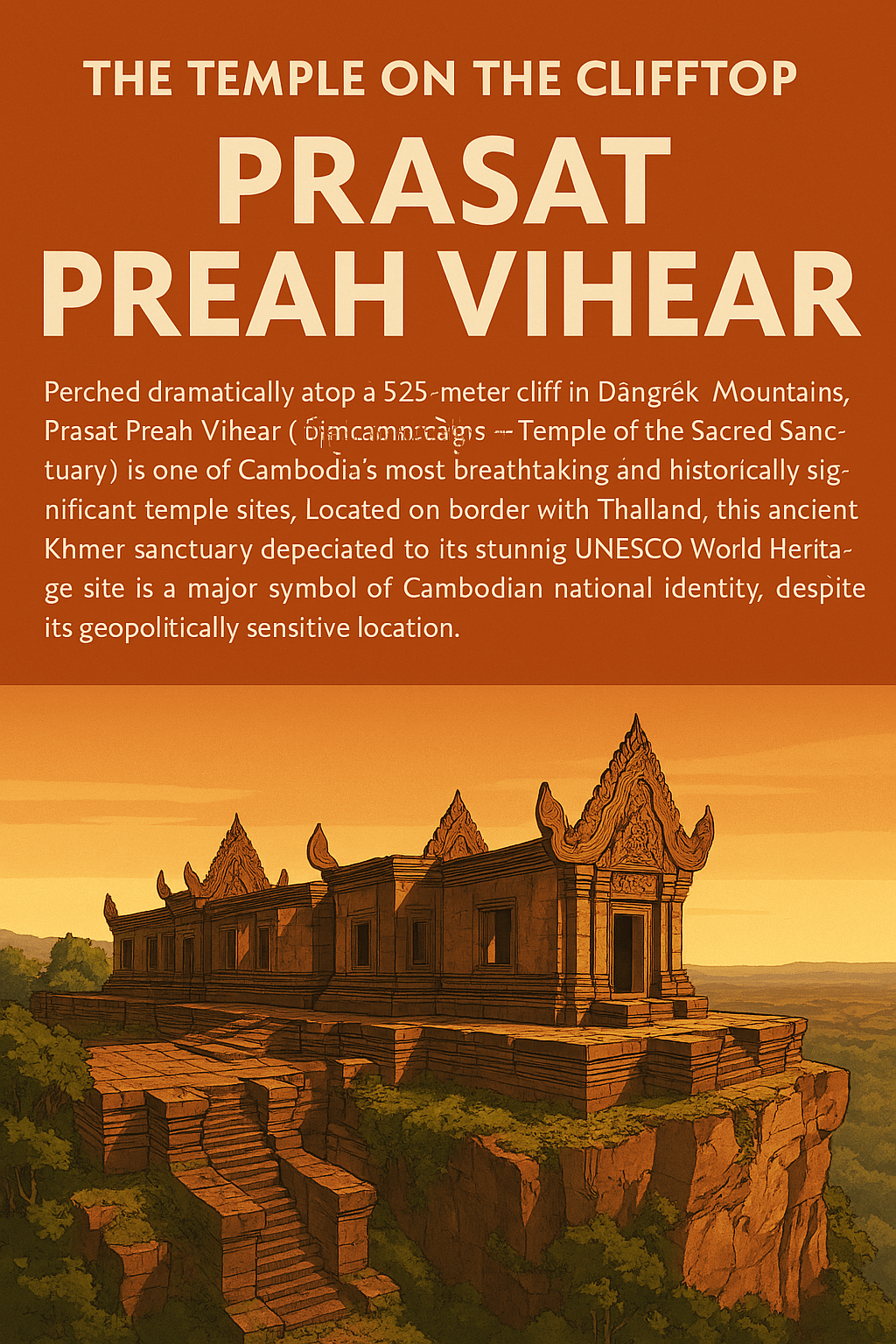Angkor Wat, the magnificent temple complex rising from the Cambodian plains near Siem Reap, stands as the undisputed zenith of classical Khmer architecture and a global symbol of human ingenuity and spiritual devotion. Built in the early 12th century during the reign of King Suryavarman II, this UNESCO World Heritage site was initially dedicated to the Hindu god Vishnu before transitioning into a major Buddhist center. Its harmonious design, monumental scale, intricate carvings, and profound symbolism represent the pinnacle of the Angkorian civilization and continue to inspire awe in visitors from around the world, holding deep significance for all Cambodians, whether living nearby or in provinces like Battambang.
Sacred Geometry: Symbolism and Hindu Cosmology
The layout and structure of Angkor Wat are a breathtaking physical manifestation of Hindu cosmological beliefs, designed as a microcosm of the universe:
- Mount Meru: The temple’s most iconic feature, the five central towers arranged in a quincunx, represent the five peaks of Mount Meru, the sacred dwelling place of the gods (Devas) in Hindu and later Buddhist mythology. The tallest, central tower symbolizes the mountain’s highest peak.
- Cosmic Ocean: The vast, rectangular moat surrounding the entire complex (measuring 1.5 km by 1.3 km) symbolizes the mythical oceans that encircle the world.
- Mountain Ranges: The concentric galleries and enclosure walls within the moat represent the chains of mountains that ring Mount Meru.
- West-Facing Orientation: Unusually for Khmer temples (which typically face East), Angkor Wat faces West. The exact reason remains debated among scholars, with theories suggesting it might have been intended as a funerary temple for King Suryavarman II (as the West is associated with death and Vishnu), or simply because Vishnu himself is sometimes associated with the West.
Monumental Feat: Construction Materials, Techniques, and Labor
The construction of Angkor Wat over several decades was an immense undertaking, showcasing remarkable engineering and organizational skills:
- Materials: The primary material is sandstone, meticulously quarried from the Kulen Hills approximately 40 km away and transported via a network of canals. An estimated 5 to 10 million sandstone blocks, some weighing up to 1.5 tons, were used. Laterite, a rough reddish stone, was used for foundations, enclosure walls, and hidden structural elements. Wooden structures, particularly roofs, were also used but have long since decayed.
- Techniques: Khmer engineers achieved stability and precision without mortar or cement. Sandstone blocks were expertly shaped to fit together tightly using dry joint masonry, relying on friction, gravity, and possibly plant-based resins. Techniques like corbelled arches and vaults (where successive stones project slightly inwards to bridge a space, rather than using a true keystone arch) were employed to roof galleries and towers. Sophisticated hydrology was essential for managing the massive moat and ensuring stable foundations in the sandy soil.
- Labor: Building Angkor Wat required a colossal, highly organized workforce, likely numbering in the tens of thousands. This included skilled artisans (sculptors, stonecutters), engineers, quarry workers, transport crews, and general laborers, mobilized under state direction.
Stone Storybooks: The Bas-Reliefs
One of Angkor Wat’s most stunning features is the nearly kilometer-long network of covered galleries adorned with intricate bas-relief carvings. These detailed stone murals depict a vast array of scenes:
- Hindu Epics: Vivid portrayals of battles and stories from the Mahabharata (like the Battle of Kurukshetra) and the Ramayana.
- Mythology: The famous “Churning of the Ocean of Milk” (Samudra Manthan), a creation myth involving gods and demons.
- History: A grand procession showing King Suryavarman II with his court, armies, and tributary groups, offering invaluable insight into 12th-century Khmer life.
- Religion: Depictions of the 32 hells and 37 heavens according to Hindu beliefs. These reliefs served multiple purposes: illustrating religious texts for the populace, glorifying the king and his divine connection, documenting historical events, and decorating the sacred space.
Celestial Temple: Astronomical Alignments
Angkor Wat incorporates sophisticated astronomical knowledge into its design:
- Equinox Alignment: The temple is precisely oriented along an East-West axis. During the Spring Equinox (around March 20th/21st), observers standing on the western causeway can witness the sun rising directly over the pinnacle of the central tower, a deliberate and dramatic alignment.
- Other Alignments: Scholars suggest other alignments related to the solstices and lunar cycles may also be encoded within the temple’s dimensions and layout, indicating a deep understanding of celestial movements by its Khmer builders.
Evolving Faith: Hindu Origins and Buddhist Transformation

Angkor Wat provides a powerful example of religious continuity and transformation in Cambodia:
- Hindu Foundation: Built by Suryavarman II, it was originally consecrated to Vishnu, representing a high point of Hindu influence and Vaishnavism in the Khmer Empire. The temple’s primary iconography and layout are fundamentally Hindu.
- Buddhist Adaptation: Following the decline of Hinduism and the rise of Theravada Buddhism as the dominant faith (particularly from the 14th century onwards, though Mahayana Buddhism was promoted earlier by Jayavarman VII in the late 12th century), Angkor Wat was repurposed for Buddhist worship. Numerous Buddha statues were added throughout the complex, niches were adapted, and it became – and remains today – one of the most important Buddhist pilgrimage sites in Southeast Asia.
Angkor in Context: Comparison with Regional Temples

Angkor Wat’s architectural achievement can be appreciated through comparison:
- Borobudur (Indonesia, 9th Century): A massive Buddhist monument built as a stepped pyramid and mandala, using volcanic stone, representing a different religious cosmology and architectural tradition.
- Bagan (Myanmar, 11th-13th Centuries): A vast archaeological zone with thousands of Buddhist temples and stupas, primarily constructed from brick, showcasing a different aesthetic and scale of dispersion.
- Other Khmer Temples: Compared to earlier temples like Banteay Srei (exquisite carving but much smaller) or later ones like the Bayon (Mahayana Buddhist cosmology, iconic face towers, different spatial feeling), Angkor Wat represents the apex of the classical Khmer temple-mountain style, unmatched in its scale, harmonious integration, symmetrical balance, and the sheer quality and extent of its bas-reliefs. It is often cited as the largest religious monument in the world.
Conclusion
Angkor Wat is an enduring masterpiece, a symphony in stone that harmoniously blends grand cosmological symbolism, sophisticated engineering, and breathtaking artistry. As the ultimate expression of the classical Khmer architectural style, it reflects both the empire’s Hindu past and its Buddhist present. Its monumental scale, intricate carvings, and precise alignments continue to captivate scholars and visitors alike. As the heart of the Khmer nation’s heritage, Angkor Wat remains a profound source of pride and spiritual significance for all Cambodians, a timeless symbol of their ancestors’ extraordinary achievements, resonating powerfully far beyond Siem Reap into provinces like Battambang as of April 2025. Sources and related content





